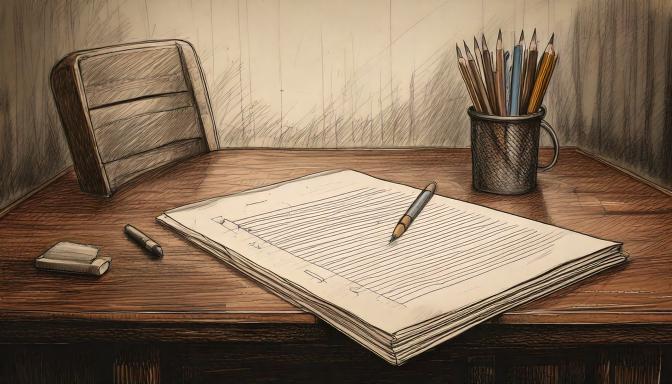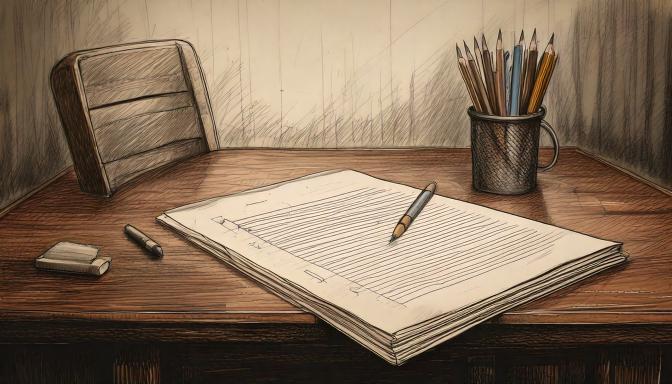Build a Powerful Scene in Your Story

That day Rain drummed against the library windows like impatient fingers tapping on a desk.
The courtyard was a soggy mess, so half the school had crammed into the library during lunch.
I was nestled between two bookshelves, scribbling story ideas in my notebook, when Yashika plopped into the seat across from me,
her tray of cafeteria pasta untouched.
She groaned dramatically and muttered, "I give up. My story sucks."
I looked up. "What happened this time?"
She made a face. "I’m writing and writing, but everything feels... flat. My scenes are dull, like someone pressed slow-motion on my story."
I couldn’t help but smile. "Flat pasta and flat scenes? Rough day, huh?"
She let out a sigh. "Very funny. Seriously, I want the story to be good, but I don’t even know how to make one scene exciting.
They just kind of... sit there."
I shut my notebook and leaned in. "Alright. Time for a crash course in scene writing—library edition. You ready to level up?"
Yashika’s eyes lit up. "Yes! Please. Teach me the magic before I cry into my pasta."
She gave me a half-hearted smile. "Easy for you to say! You’re always writing these exciting stories. Mine feel like they’re stuck in slow motion."
"Yashi, trust me. Everyone starts there. But once you understand how scenes work, writing becomes way more fun.
I’ll walk you through it—scene by scene!"
Yashika perked up immediately and opened her notebook. "I’m ready. Teach me the magic."
"No need to write just yet. First, I want you to understand how a scene works, like really get it.
I’ll give you the notes after we chat, promise."
I continued.
"What Exactly Is a Scene?"
"Think of a scene like a building block of your story. If the story is a movie, the scenes are the individual moments that keep the action moving."
I tossed a pebble toward a patch of ants marching along the roots of the tree.
"In every scene, your character needs to want something. Then something—or someone—gets in the way. And finally, your character reacts or makes a choice."
Yashika raised an eyebrow. "So, like a mini story inside the big story?"
"Exactly!" I grinned. "If your character is just walking around and nothing’s happening, then that’s not a scene—it’s a nap.
We need tension, movement, emotion."
I gave her a scenario.
"Imagine your character, Zara, wants to sneak her sketchbook back from her locked classroom. But—uh-oh—the art teacher walks in. What does she do? Hide? Lie? Run? That’s a scene!"
"Why Are Strong Scenes So Important?"
Yashika leaned forward, completely hooked now.
"Because boring scenes make readers quit," I said, swatting a mosquito.
"You ever watched a movie where people just talk and nothing actually happens?"
"Ugh yes. I check my phone five minutes in."
"Same with stories. Every scene needs to DO something. Show the character’s actions. Reveal something new. Change the story somehow."
She nodded quickly. "Okay. So what makes a scene strong?"
"Use the Scene Sandwich!"
I laughed. "You’re going to love this—think of your scene like a sandwich."
Yashika blinked. "I’m listening. Food always makes things better."
"Great! Here's the sandwich formula:
Top slice: Start with what your character wants.
Filling: Throw in a challenge or problem.
Bottom slice: End with a reaction or a choice.
"Let’s say Zara wants her sketchbook (top slice). But the art teacher walks in (filling). She decides to hide under the desk and wait (bottom slice). Boom! We’ve got tension, a decision, and movement."
Yashika laughed. "This actually sounds fun. It’s like a puzzle!"
"How Do I Organize All My Scenes?"
She chewed on her pen cap, then asked, "Okay, so I get how one scene works. But how do I make all the scenes work together?"
"That’s where structure comes in! Let’s try the classic 3-part story structure."
I picked up a twig and drew three sections in the dirt.
Part 1: "The Beginning (Setup)"
"This is where we meet the main character and see what their life is like. Then—something big changes."
Yashika added, "Like losing the sketchbook?"
"Exactly. You also show us what’s normal, then break that normal with a problem."
Part 2: "The Middle (Rising Action)"
"Now it gets tricky. The character tries to fix the problem but ends up facing bigger challenges."
"Like the art teacher doesn’t leave, and now Zara’s stuck under a desk with her stomach growling!"
"Yes! Things keep getting worse or weirder. We watch her grow or struggle. Maybe she even teams up with someone unexpected."
Part 3: "The Ending (Climax and Resolution)"
"Time for the big moment—the showdown!"
"Zara finally grabs the sketchbook, but—wait—the teacher catches her?"
"Maybe! And maybe instead of punishing her, the teacher offers to help her submit her art to a contest. Zara goes from sneaking to shining."
Yashika clapped. "That’s awesome! I want to write this now."
"Want to Go Big? Try the Hero’s Journey Map"
"You want to make your story feel like an epic adventure? Use the Hero’s Journey."
Yashika leaned back on the grass, staring at the sky. "Okay, hit me."
"Here’s the short version:
- Normal life.
- Something calls the hero to action.
- They say no (at first).
- They meet a mentor.
- They enter a new world.
- Face tests, make friends, meet enemies.
- Get closer to the goal.
- Face the ultimate challenge.
- Succeed (or learn something big).
- Return home changed.
"Each step can be its own scene! Think of it like an adventure map."
"How Do I Know If a Scene Works?"
"Simple. Ask yourself these five things:"
- What’s the purpose of this scene?
- Does something change by the end?
- Is there a problem or conflict?
- Does my character grow or react?
- Will readers care what happens next?
"If you say yes to most, you’re golden."
"Pro Writer Tips!"
Yashika was scribbling like her hand was on fire. I tossed in a few last tips for her notebook:
- Start in the middle of the action.
- Use specific details—don’t say “messy,” say “three pizza boxes and a sock from last year.”
- Make your characters feel real—let them sweat, grin, panic.
- End with a hook—a twist, a cliffhanger, or a juicy question.
"Final Words, Scene Builder!"
"Yashi, listen. Writing strong scenes isn’t about being perfect. It’s about building one moment at a time that truly matters."
She looked at me thoughtfully. "So… it’s okay if I mess up a scene as long as I keep writing?"
"Totally! Write messy. Fix it later. Just make your characters want something, face a problem, and do something about it. That’s it!"
She smiled wide. "I’m going home and writing Zara’s story today."
"Good. And I want to read it tomorrow under this same tree."
She got up, dusted off her jeans, and said, "Deal. You bring the sandwich next time."
I laughed. "Fine. But only if your scene sandwich is well made too!"










